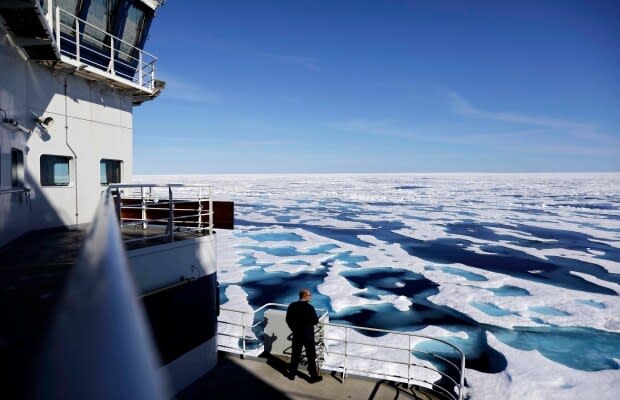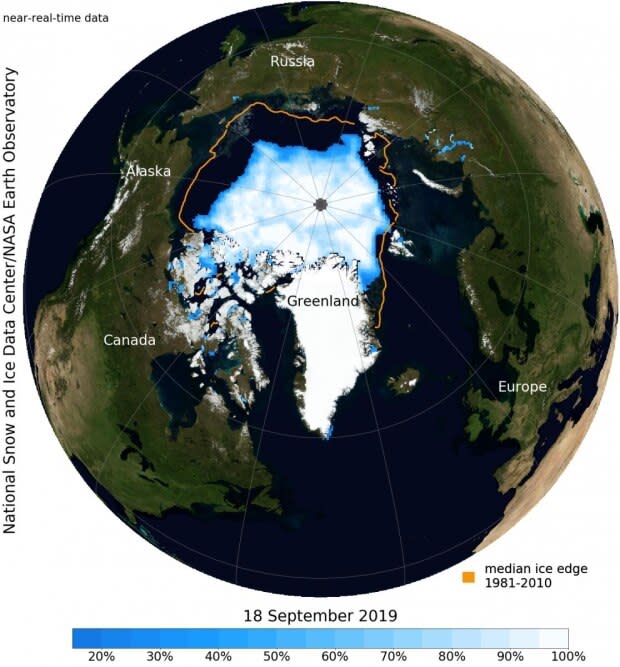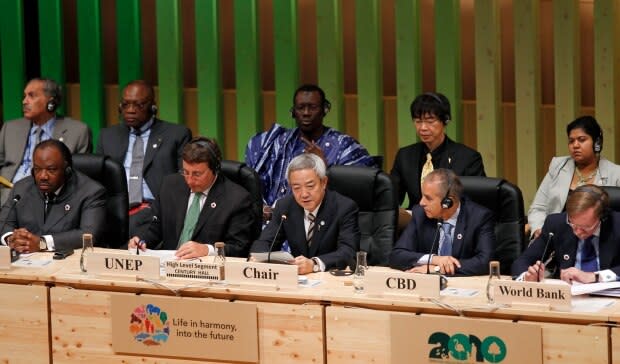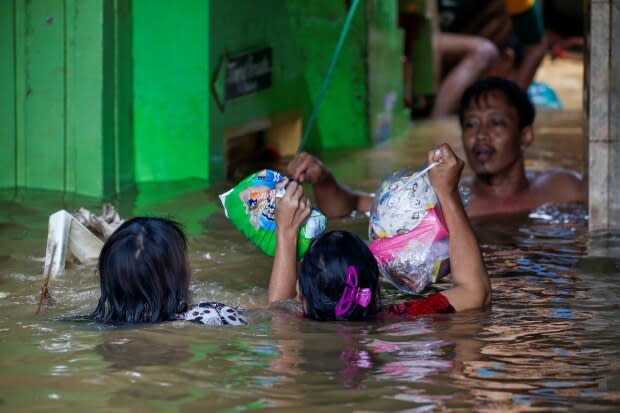'Tangled ball of issues': Why geoengineering our climate raises serious ethical, scientific challenges
As global carbon emissions continue to rise despite warnings from the scientific community, there's been increased interest in a controversial method to potentially mitigate the rise in Earth's temperature: Geoengineering.
The conversation around geoengineering — or the deliberate manipulation of our environment — is gaining traction as climate projections remain dire.
Scientists, including the Intergovernmental Panel on Climate Change (IPCC), have repeatedly cautioned that emissions need to be rapidly cut in order to keep the world from warming 1.5 C or 2 C above pre-industrial times — the threshold that would result in widespread damage and suffering.
But with emissions still on the rise, some researchers are now calling for a closer look at more experimental measures, ones that could be pursued alongside emissions cuts.
One of the more popular forms of geoengineering is known as solar radiation management, or SRM.
But SRM is fraught with questions — both ethical and scientific.
"We're thinking of this as a means to address climate change," said Anna-Maria Hubert, an international environmental law expert at the University of Calgary. "So you have to situate it within the broader climate debate about what kinds of technologies we want to use. What are their risks? Are they socially acceptable?
"And it's particularly tricky when you're talking about something global because these questions are very much socially and culturally embedded."

In one proposed type of SRM, a material, like sulphur or calcium carbonate, is sprayed into the stratosphere to produce a "global dimming," or a decline in solar energy reaching Earth's surface. It's similar to what occurs after a major volcanic eruption.
Another type is known as marine cloud brightening, where an aerosol of seawater particles would be released in low-lying clouds, increasing cloud cover. It's an idea born from ship tracks, or the clouds that form in some vessels' wakes.
With both methods, the concept is that particles in the atmosphere would reflect solar radiation back into space, rather than allowing it to be absorbed by the Earth. (The reflectivity of an object is known as its albedo.)
The overall goal is to create a cooling effect for the planet.
The white snow and ice of the Arctic has done this for thousands of years. But with Earth's warming temperatures, that snow and ice is melting, increasingly allowing radiation to be absorbed in the now-dark waters at the pole.
Perhaps an even larger issue: How do you get an entire planet to agree on something that knows no borders?
International agreement may be particularly challenging, Hubert noted, at a time when the world's most powerful nation is retreating from multilateral agreements, including trade agreements and, on the climate change, withdrawing from the Paris Agreement. The U.S. is the world's second-largest emitter of greenhouse gases.
Scientific challenges
In January, the U.S. National Oceanic and Atmospheric Administration (NOAA) received $4 million from Congress to study geoengineering.
David Fahey, director of the chemical sciences division at NOAA's Earth System Research Laboratory, said the research is not about whether the government agency will condone geoengineering, but rather that it's better understood, since most work has been done in labs or using models.

NOAA's mission is to be "stewards of the oceans and atmosphere," an objective they take very seriously, said Fahey.
And as stewards, he said it's important that the agency is at least be involved in the planning stages of the discussion, in order to examine the science and feasibility of such a monumental task.
"With geoengineering today, it's a tangled ball of issues," he said.
Any tests that can be performed would have to be done on a small, local scale. But the tricky part to testing on a small scale is that you truly don't know the consequences or repercussions until you do it on a larger scale.
Simply put, the only real way to understand what would happen is to actually do it.
But any deployment of solar geoengineering would be an experiment "in and of itself," noted Hubert.
"You wouldn't really know whether or how it's working, and you'd have to rely on models for quite a long time afterwards to really show what's going on in the system," she said. "It would definitely be a leap of faith — no matter how much small-scale research you did in advance."
The idea of turning to geoengineering has been raised before. But in 2010, the United Nations put a moratorium on such technologies "until there was an adequate scientific basis on which to justify such activities." An exception was made for research.

Today, some of the most prominent research is currently being done at Harvard, headed in part by Canadian David Keith, a professor of applied physics at the John A. Paulson School of Engineering and Applied Sciences.
One project, known as the Stratospheric Controlled Perturbation Experiment (SCoPEx), plans to use a propeller-driven balloon that would be positioned in front of the sun, some 20 kilometres above the southwest U.S. Once in place, it would release a small amount of material, likely calcium carbonate, and then observe how the particles disperse.
The research is being overseen by an advisory board, created in July 2019, ahead of a planned test.
"I think it's important for people to discuss these issues more seriously and to do research, so we understand more about the risks and how well these things work and how they might be governed," Keith said.
There is no confirmed date for the test.
Ethics and governance
Beyond determining whether such geoengineering can be done, the question that's often raised is should it be done?
Some considerations — including those related to ethics, social acceptability and governance — were raised in the IPCC's landmark 2018 report. (Note: The IPCC does not use the term geoengineering, but separates SRM from carbon dioxide removal and other techniques.)
It's clear that not everyone is a fan of changing Earth's albedo.
"I think albedo modification, by and large, is a terrible idea," said Emily Cox, an environmental policy researcher at both Cardiff University and the Tyndall Centre for Climate Change Research in the U.K.
"Not necessarily because of the cross-border impacts, but because every time you put it in a model, it changes precipitation patterns — and this is not good."
Importantly, she said, changes in precipitation patterns will more greatly affect the most vulnerable populations.
"If you're talking about justice and equity, then the impacts of changing rainfall patterns is going to fall disproportionately on the poorest around the world."
Keith disagrees, pointing to a paper he co-authored published last year in the journal Nature Climate Change that he says "contradicts that assumption."

And there remains the issue of getting the entire world to agree on using SRM, since any effort will impact everyone. What would its governance look like?
David Cooper, deputy executive secretary of the UN Convention on Biodiversity, argues that "one could only legitimately proceed on something of scale if you have a multilateral agreement to do so."
"The central question behind this is: who decides and the power relations behind that," he said. "It's important … that any decisions on this need to be taken multilaterally and collectively, and informed by public discussion that involves all groups … particularly Indigenous communities and local communities."
Another concern relates to something called a "moral hazard," or the argument that if SRM were deployed, it might be an excuse for some to claim that eliminating CO2 emissions isn't necessary.
Keith recognizes these concerns and agrees that SRM isn't a catch-all solution; emissions still need to be cut, he said.
"Do I think … that it might be politically exploited by forces that want to block emissions cuts, like big oil companies who will lie and say that emissions do not need to be cut? Or that it's an excuse to avoid emissions cuts?" Keith said. "Do I think that is a political risk? Yes, very clearly."
Cox argues that there's another way to think about it: Some research into moral hazards has found that they can go both ways. With SRM, for example, it may actually galvanize people who hadn't realized the climate situation was so dire, into making greener choices.
And no matter whether or not SRM is deployed, experts agree more research needs to be done — even on a small scale.
"Generally, people are favourable toward research under controlled conditions," said Cox. "The problem is how much you can actually tell from that research."


